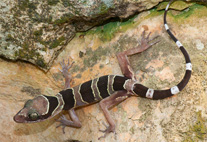Abstract
Two new species of Aphanius are described from the Kol drainage in southern Iran (Aphanius darabensis n. sp.) and the endorheic Kavir Basin in northern Iran (A. kavirensis n. sp.), and compared with eight closely related species. Aphanius darabensis n. sp. is sister to A. shirini, from which it is distinguished by molecular characters (cytochrome b) and the combination of three morphological characters: 9–18 flank bars in males (vs. 7–10), females with irregular vertical patches of brown color on the flank (vs. prominent dark brown blotches of round or irregular shape), and symmetrically-shaped triangular to trapezoid otoliths with a rostrum distinctly longer than the antirostrum (vs. quadrangular to trapezoid otoliths with short and equally sized rostrum and antirostrum). Aphanius kavirensis n. sp. is closely related to a group containing A. sophiae, A. mesopotamicus and A. pluristriatus, from which it is distinguished by cytochrome b characters and the combination of three morphological characters: females with irregularly arranged large blotches of dark brown color on the flank, short pectoral fin in both sexes (13.4–18.1% SL in males, 11.2–18.3% SL in females), and asymmetrically shaped triangular to trapezoid otoliths with a pronounced predorsal region. Our tree based on the cytochrome b data demonstrates that the Iranian inland and inland-related Aphanius species (IIRAS) form a monophyletic clade with three subclades (A. vladykovi -, A. shirini -, A. sophiae subclades). The A. sophiae subclade, which is the most diverse of the three subclades, can be further divided into three lineages (A. isfahanensis -, A. farsicus -, A. sophiae lineages). The temporal diversification of the IIRAS clade is discussed and two evolutionary groups of Aphanius are depicted. Aphanius vladykovi, together with A. shirini, A. darabensis n. sp. and A. isfahanensis characterize the “old” evolutionary group. Their divergences may have happened 10–5 m.y. ago (Late Miocene–Early Pliocene). Aphanius farsicus, A. arakensis, A. sophiae, A. mesopotamicus, and A. pluristriatus, together with Aphanius kavirensis n. sp., represent the “young” evolutionary group, which developed in the Late Pleistocene (100,000–11,700 y. ago) and Early to Middle Holocene (c. 11,700–4,000 y. ago).

